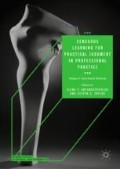Abstract
This chapter aims to share arts-based inquiry and its implications, and present results showing how this learning approach can produce answers not previously seen, given value or discovered. In arts-based inquiry, one can access sensuous and embodied knowledge, foster creativity and reflexivity and uncover deeper and more authentic solutions through deliberate identification with a chosen artefact or symbol. The main setting is a tailor-made course at Oslo Metropolitan University. This non-traditional program aims to develop the participants’ creative skills and improve their ability to create change and innovation in their personal and working lives. Meltzer illustrates the method and its results through a number of examples and pictures.
Access this chapter
Tax calculation will be finalised at checkout
Purchases are for personal use only
References
Antonacopoulou, E. P. (2014). The Experience of Learning in Space and Time. Prometheus, 32(1), 83–91.
Antonacopoulou, E. P., & Sheaffer, Z. (2014). Learning in Crisis: Rethinking the Relationship between Organizational Learning and Crisis Management. Journal of Management Inquiry, 23(1), 5–21.
Barnes, D. (1998). Forward: Looking Forward: The Concluding Remarks at the Castle Conference. London: Falmer Press.
Brantmeier, E. J. (Ed.). (2013). Pedagogy of Vulnerability: Definitions, Assumptions, and Applications. Charlotte, NC: Information Age Publishing.
Buswick, T., & Seifter, H. (2010). Editor’s Note. Journal of Business Strategy, 31(4), 1–5.
Caliskan, H. (2012). Inquiry Learning. In N. M. Seel (Ed.), Encyclopedia of the Sciences of Learning (pp. 1571–1573). New York, NY: Springer.
Clottes, J., & Lewis-Williams, D. (1998). The Shamans of Prehistory. Trance and Magic in the Painted Caves. New York: Harry N. Abrams, Inc.
Darsø, L. (2004). Artful Creation: Learning-Tales of Arts-in-Business. Frederiksberg: Samfundslitteratur.
Darsø, L. (2017). Co-Creating Meaning Through Artful Inquiry. In T. Chemi & L. Krogh (Eds.), Co-Creation in Higher Education (pp. 131–149). Rotterdam: Sense Publishers.
Dispenza, J. (2017). Becoming Supernatural. How Common People Are Doing the Uncommon. New York: Hay House.
Edwards, C. P., Gandini, L., & Forman, G. (1993). The Hundred Languages of Children: The Reggio Emilia Approach to Early Childhood Education. Norwood, NJ: Ablex.
Eide-Midtsand, N. (1987). En kritikk av fortolkning som teknikk i barneterapier. Tidsskrift for Norsk Psykologforening, 24, 3–11.
Finley, S. (2003). Arts-Based Inquiry in QI: Seven Years from Crisis to Guerrilla Warfare. Qualitative Inquiry, 9(2), 281–296.
Gendlin, E. T. (1969). Focusing. Psychotherapy: Theory, Research & Practice, 6(1), 4–15.
Gendlin, E. T. (1986). Let Your Body Interpret Your Dreams. Wilmette, IL: Chiron Publications.
Gendlin, E. T., & Olsen, L. (1970). The Use of Imagery in Experiential Focusing. Psychotherapy: Theory, Research & Practice, 7(4), 221–223.
Høgskolen i Oslo og Akershus, i. f. y. (2011). Kreativ kommunikasjon. Ledelse av kunstneriske prosesser som bidrag til utvikling på arbeidsplassen. Programplan (vol. 2011). Oslo: HiOA.
Jung, C. G., von Franz, M. L., Henderson, J. L., Jacobi, J., & Jadde, A. (1964). Man and His Symbols. London: Aldus Books Ltd.
Malchiodi, C. A. (2007). The Art Therapy Sourcebook (2nd ed.). New York: McGraw-Hill.
Meltzer, C. (2015). Understanding the Ambiguity and Uncertainty in Creative Processes When Using Arts-Based Methods in Education and Working Life. Organizational Aesthetics, 4(1), 46–69.
Meltzer, C. (2016). Life in Noah’s Ark: Using Animal Figures as an Arts-Based Projective Technique in Group Work to Enhance Leadership Competence. Organizational Aesthetics, 5(2), 77–95.
Montuori, A. (2012). Creative Inquiry. In N. M. Seel (Ed.), Encyclopedia of the Sciences of Learning (pp. 833–837). New York, NY: Springer.
Moxnes, P. (2012). Positiv angst i individ, gruppe og organisasjon: Et organisasjonspsykologisk perspektiv (4th ed.). Oslo: Universitetsforlaget.
Ronnberg, A., & Martin, K. (Eds.). (2010). The Book of Symbols. Reflections on Archetypal Images. Køln: Taschen.
Scharmer, C. O. (2010). Teori U. Lederskab der åbner fremtiden. Mod en ny social teknologi - presencing (3rd ed.). Hinnerup: Forlaget Ankerhus.
Scharmer, C. O., & Kaeufer, K. (2010). In Front of the Blank Canvas: Sensing Emerging Futures. Journal of Business Strategy, 31(4), 21–29.
Schön, D. A. (1991). The Reflective Practitioner: How Professionals Think in Action. Aldershot: Arena.
Springborg, C. (2014). Art-Based Methods in Management Education. Cranfield: Cranfield University.
Storr, A. (1988). Solitude. A Return to the Self. New York: Ballantine Books.
Taylor, S., & Ladkin, D. (2009). Understanding Arts-Based Methods in Managerial Development. Academy of Management Learning and Education, 8(1), 55–69.
Trevelyan, C., Crath, R., & Chambon, A. (2014). Promoting Critical Reflexivity Through Arts-Based Media: A Case Study. British Journal of Social Work, 44, 7–26.
Winnicott, D. W. (1971). Playing and Reality. New York: Basic Books.
Author information
Authors and Affiliations
Corresponding author
Editor information
Editors and Affiliations
Rights and permissions
Copyright information
© 2019 The Author(s)
About this chapter
Cite this chapter
Meltzer, C. (2019). Using Arts-Based Inquiry as a Way to Communicate Creatively in Uncovering the Future. In: Antonacopoulou, E., Taylor, S. (eds) Sensuous Learning for Practical Judgment in Professional Practice. Palgrave Studies in Business, Arts and Humanities. Palgrave Macmillan, Cham. https://doi.org/10.1007/978-3-319-98863-4_7
Download citation
DOI: https://doi.org/10.1007/978-3-319-98863-4_7
Published:
Publisher Name: Palgrave Macmillan, Cham
Print ISBN: 978-3-319-98862-7
Online ISBN: 978-3-319-98863-4
eBook Packages: Business and ManagementBusiness and Management (R0)

